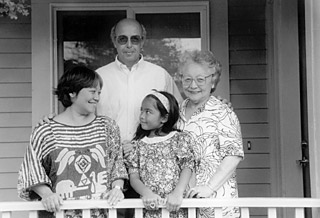Female Caregiving, Disability, and the Family
Another one of our favorite myths about the family centers around the figure of the mother, the compassionate, nurturing caregiver who puts everyone else’s needs before her own. As feminists have argued, this vision does a disservice not only to individual women, but also to their partners and children. It has placed unreasonable burdens on mothers who wish to work or who are disinclined to act in a traditional mothering role, and it has prevented men from developing their own ability to nurture and share in child-care responsibilities. As feminists such as Ann Crittenden have argued, our current socioeconomic system depends, in large part, on families buying into this powerful ideology of motherhood. 1 Through the labor they freely perform as caregivers, mothers have absorbed the hidden costs of capitalism. Yet because child rearing has been pushed into the private realm, out of sight of the public world of work, we often do not see the connections. In the same way that female caring for children has been relegated to the private world (whether the caregivers are mothers, nannies, or day-care workers), so have the issues surrounding the care of the elderly, the terminally ill, and the disabled. 2
Caring for the disabled is an important feminist issue. The overwhelming majority of caregivers for the disabled population are female. 3 According to researchers Marty Krauss and Marsha Seltzer, after mothers, sisters are more likely than brothers to care for their siblings. 4 Indeed, on SibNet, an Internet support group for siblings of individuals with disabilities, the majority of the participants are, like me, sisters. Outside of close family members, the two main groups of people who help care for individuals with disabilities—employed caregivers and human services professionals—are likely to be women. 5 (Employed caregivers also tend to be women of color who are often underpaid and overworked for their labor, producing inequities that can undermine the compassionate caring that all individuals, including the disabled, deserve. 6) My sister’s case is no exception: Aside from my father and my sister’s boss, all her caregivers are women.
The issues facing the disabled and their caregivers are particularly complex. To begin with, many individuals, such as my sister, need some level of care for their entire lives. My sister has accomplished what is, for her, a high level of self-sufficiency (a praiseworthy accomplishment, and particularly so in a culture that disdains neediness and esteems independence); but the reality of her life is one of interdependence. And in order to do things like work and live apart from my parents, to live “independently,” she needs daily help. Not a lot, perhaps, but enough: a ride to work and to the grocery store, a reminder to turn off the oven, a helping hand with her bank account. Other individuals with disabilities need far more assistance than she does; and given the short supply of compassionate, well-compensated caregivers, it is no wonder that so many adults with disabilities continue to live with their parents. 7 In failing to provide adequate support to these families, our country places them under a lot of strain. Many of them live in varying degrees of isolation, creating conditions under which unhealthy psychological codependencies can develop between the disabled and their caregivers.
What, then, can feminism offer disabled individuals and their caregivers—or, perhaps I should say, what can the experience of disability offer feminism? How can we remedy situations where disabled individuals are thwarted, caregivers not well compensated, and families overwhelmed? As many scholars have suggested, the answer partly lies in placing a higher value on the labor of caregiving. As Eva Feder Kittay argues, we need to integrate the principle of care into our concept of justice. 8 It was equality, after all, that inspired both the feminist and disability rights movements to stand up for the rights of women and of individuals with disabilities; and as a result, people like my sister are finally being seen as full human beings and citizens with equal rights. The next step, however, is to provide better support for individuals like my sister—for all individuals—in the context of the interdependent relationships of family.
What our country needs, in other words, is a vision of family that acknowledges our complex interdependencies. By listening to and learning from the experiences of individuals with disabilities and their families, we can rethink the operating terms and assumptions of social policies and work toward a society that can nurture all families—both the ones we are born into and the ones we forge along the way.
- See also Susan Douglas and Meredith Michaels’s The Mommy Myth: The Idealization of Motherhood and How It Has Undermined Women.[↑]
- Susan Wendell.[↑]
- See Eva Kittay’s Love’s Labor and Barbara Hillyer.[↑]
- In a five-year study tracking 462 families, Krauss and Seltzer found that 64.2 percent of the siblings who took care of their disabled brother or sister were women.[↑]
- Hillyer.[↑]
- Kittay, “When Caring is Just and Justice is Caring: Justice and Mental Retardation.”[↑]
- The number of aging parents caring for adult children with disabilities is increasing; over half a million mentally retarded and developmentally disabled Americans live with their elderly parents, a number which is expected to double over the next 25 years. See Olivas.[↑]
- Kittay, Love’s Labor.[↑]



